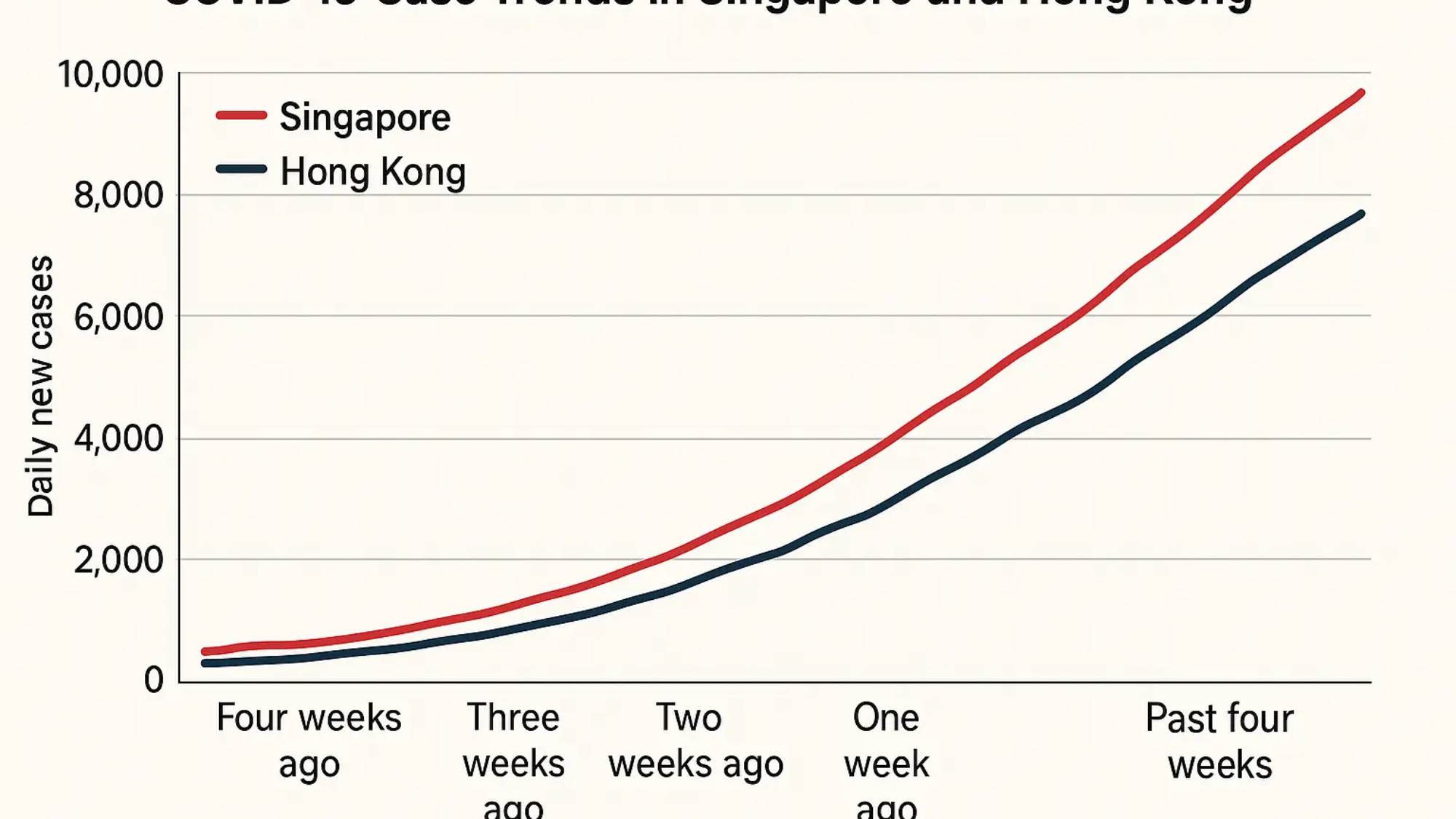Health authorities in Singapore and Hong Kong have raised urgent alerts after reporting a sharp rise in COVID-19 infections. Wastewater surveillance, hospital admissions, and laboratory testing data all point toward a potential new wave in these densely populated city-states. This comprehensive update covers the latest epidemiological data, public health responses, vaccination efforts, and guidance for residents and travelers.
1. Recent Epidemiological Trends
1.1 Hong Kong: One-Year High in Positive Tests
- Current Situation: Hong Kong’s Centre for Health Protection reports that the percentage of respiratory samples testing positive for SARS-CoV-2 has reached its highest level since May 2024.
- Severe Cases: In the week ending May 3, there were 31 severe COVID-19 cases, the highest weekly toll in roughly 12 months.
- Wastewater Signals: Elevated viral loads detected in sewage surveillance indicate widespread community transmission, often preceding clinical surges by 1–2 weeks.
1.2 Singapore: 28% Week-on-Week Increase
- Infection Spike: Singapore’s Ministry of Health reported approximately 14,200 infections in the week ending May 3—a 28% increase compared to the prior week.
- Hospitalizations: COVID-related hospital admissions rose by about 30% over the same period, placing additional strain on healthcare resources.
- First Update in a Year: This was the first official epidemiological update from Singapore’s health authorities since mid-2024, underscoring the suddenness of the surge.
2. Public Health Responses
2.1 Alerts and Warnings
- Hong Kong: The Centre for Health Protection has issued a Level-2 alert, advising residents to maintain mask-wearing in crowded indoor settings and to avoid large gatherings.
- Singapore: The Ministry of Health has reinstated advisories on social distancing, mask-on-public transport, and encouraged employers to facilitate work-from-home arrangements where feasible.
2.2 Surveillance Enhancements
- Sewage Monitoring: Both cities have ramped up wastewater testing at key catchment areas to detect early upticks in viral load.
- Rapid Testing: Free community antigen rapid test (ART) kits are being distributed to vulnerable groups—elderly, immunocompromised, and frontline workers.
3. Vaccination and Booster Campaigns
3.1 Current Coverage
- Hong Kong: Approximately 78% of the population has received at least two doses, but booster uptake remains at 45%—below the target 70%.
- Singapore: Over 85% have completed the primary series, with booster coverage at 65%. Authorities are now offering mobile vaccination buses to improve access.
3.2 Targeted Outreach
- Elderly Focus: Priority booster clinics are open seven days a week, with home-visit options for immobile seniors.
- Workplace Clinics: Pop-up vaccination sites at major business districts and shopping malls aim to reach working adults.
- Public Education: Multimedia campaigns address vaccine hesitancy by highlighting safety data and effectiveness against severe disease.
4. Impact on Healthcare Systems
4.1 Bed Utilization
- Singapore: COVID-19 bed occupancy climbed to 65% of the designated isolation capacity, compared to 50% two weeks ago.
- Hong Kong: Isolation wards report 70% utilization, prompting hospitals to convert general wards as contingency.
4.2 Staffing and Resources
- Staff Redeployment: Non-urgent elective procedures are being postponed, and additional nursing staff are being deployed to isolation units.
- Adequate Supplies: Both cities report sufficient stocks of antivirals (e.g., Paxlovid) and monoclonal antibodies, but rapid replenishment protocols are in place to prevent shortages.
5. Social and Economic Implications
5.1 Travel and Tourism
- Transit Hubs on Alert: Changi Airport (Singapore) and Hong Kong International Airport have reinstated thermal screening for inbound passengers from high-risk regions.
- Business Travel: Companies are reviewing travel protocols; some multinationals are delaying regional conferences until the wave subsides.
5.2 Public Events
- Event Cancellations: Major concerts and festivals are being postponed or held at reduced capacity; popular Hong Kong singer Eason Chan canceled his Taiwan dates after testing positive.
- Retail Footfall: Shopping malls and restaurants report a 10–15% dip in weekday foot traffic as consumers grow cautious.
6. Expert Insights
“We’re seeing a classic respiratory pathogen resurgence, driven by waning immunity and seasonal factors. Early indicators from sewage and clinic visits give us a narrow window to act,”
— Dr. Miriam Lee, Epidemiologist, Asia Public Health Alliance
“Boosters remain our best tool to prevent severe outcomes. Urban density in Singapore and Hong Kong makes these surges inevitable without regular revaccination,”
— Prof. Alan Chow, Infectious Disease Specialist, National University of Singapore
7. Protective Measures for Residents
- Mask Up: Wear well-fitted masks in crowded or poorly ventilated indoor spaces.
- Test Early: Use free or low-cost ART kits at the onset of any respiratory symptoms.
- Boost Immunity: Book booster appointments, especially for those aged 50+ or with chronic conditions.
- Hygiene Practices: Maintain regular hand hygiene and respiratory etiquette.
- Stay Informed: Follow official updates on MOH (Singapore) and CHP (Hong Kong) websites for real-time advisories.
8. Looking Ahead: What to Watch
- Viral Sequencing: Monitoring for novel variants that may evade immunity.
- Hospital Strain: Bed occupancy trends and ICU admissions over the next 2–4 weeks.
- Vaccination Uptake: Booster campaign progress will be crucial to mitigating severe disease.
- Regional Spread: Similar surges in neighbouring Malaysia and Thailand may have cross-border implications.
Conclusion
The rapid uptick in COVID-19 cases in Singapore and Hong Kong underscores the persistent threat of new waves, even as the virus becomes endemic. With epidemiological signals pointing toward broad community transmission, timely public health interventions, sustained vaccination efforts, and individual vigilance are imperative to minimize illness, hospitalizations, and societal disruption.
Stay updated via official channels and consider this a reminder: the fight against COVID-19 continues, and preparedness remains our strongest defense.


Add a Comment